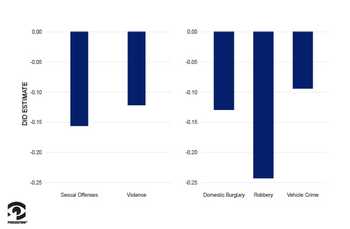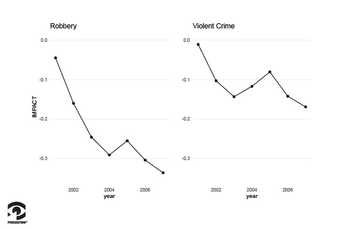This blog is a part of our series, "Perspectives in Crime" where we explore leading academic studies that touch on crime data.
Neighborhood renewal programs are place based initiatives designed to improve economic and social outcomes in disadvantaged communities. A recent study analyzed the impact of a specific renewal project targeting distressed communities in England. While prior analysis has demonstrated that multi agency renewal programs have generated social and economic value within disadvantaged areas, this research has generated limited empirical evidence. The paper, by Jose Alonso, Rhys Andrews, and Vanesa Jorda, studied the impact of neighborhood renewal programs on crime rates in targeted UK communities from 2000-2007.
The Neighborhood Renewal Fund (NRF) distributed about £1.875 billion pounds from 2001 to 2006, and an additional £525 million from 2007-2008. The money was distributed among local agencies working to narrow the gap in social and economic outcomes in the targeted communities with the rest of England. Selected areas received about £4 million each year of the program.
Crime reduction is a fundamental concern of the government. It is simultaneously a signal and cause of further social and economic despair in communities. Crime also serves as a meaningful signal of community health because it is consistently recorded and published. National level reporting of violent and property crimes enabled study and comparison of NRF selected areas with areas that did not receive money from the renewal fund.
Impact of the Neighborhood Renewal Fund (NRF)
Treatment areas were selected by low ranking among six economic indicators, including employment and general wages and overall ward rank by economic output. NRF resources were subsequently given to Local Strategic Partnerships (LSPs) within underperforming and disadvantaged areas. Targets were set for improvements based on a variety of indicators including crime rate, school test scores, employment rates, housing quality, and mortality rates. LSPs worked with Crime and Disorder Reduction Partnerships (CDRPs) comprised of police, probation, and health services representatives as well as private and nonprofit organizations to create crime prevention strategies.
LSP and CDRP tactics — which were used to leverage NRF funds into meaningful crime change — varied from area to area but commonly included target hardening, increased visibility of policing presence (more officers, more community service officers), youth diversion activity (extra-curricular activities), and risk offending management. These popular crime prevention strategies each had varying degrees of empirical evidence to support their efficacy on reducing criminal activity. Additional NRF funding was directed towards improving community health, employment, and education outcomes.
To study the impact of NRF funds dispersed in local areas, Alonso et al. collected data from all of England’s 345 local areas from publicly available police recorded crime statistics published by the UK’s home office. Researchers compared the annual crime data concerning victimization rates of both property and violent crimes in both the 81 local areas treated with NRF funds and the remaining 264 local areas.
Downward trajectory of crime rates
Using difference-in-differences (DiD) models and assuming that the general trends of crime rates would be similar between funded and nonfunded areas, analysis found that property crime decreased at a faster rate in funded areas than in nonfunded areas. Their estimates suggested the NRF program reduced domestic burglary by about 13%, vehicle crimes by about 9% and robbery by about 24%. The study years captured increasing violence nationwide but found that violence increased at a slower rate in local areas that had received NRF funds.
Figure 1 shows the DiD estimates for the NRF program’s overall impact on crime rates, broken down by offense:

The figure shows significant effects of program participation on all analyzed offense rates, particularly robbery.
Alonso et al. analyzed the change in property crime over time and found that the positive impact of NRF funds became apparent from the year 2003 on, but that dampening effects for all property offenses reached their peak in 2007. Violent and sexual offense showed a similar story over time but with appreciable differences manifesting in 2002, with the peak reduction in sexual offenses of -19% in 2006.
Figure 2 demonstrates the estimated program impact of violent crimes against persons (excluding sexual offenses) and robbery in NRF funded local areas.

In the above figure, 2002 marks the first year of program participation. Both crime types display a downward trajectory through the study years. During the study, property crimes declined across all of England, but at a more aggressive rate in treatment areas. Violent crimes rose across England during the study period, but NRF funded communities experienced more modest increases.
Alonso et al. found that a £1 per capita increase in NRF funding is associated with a reduction in domestic burglary and vehicle crime of about 0.3% and reduction in robbery victimization of 0.6%. Similarly, NRF funding was associated with a 0.3% reduction in violent crime victimization and 0.5% reduction in sexual offense victimization. Treated local areas in the NRF program study period received on average £21.64 per capita.
Is crime displaced in targeted areas?
Though researchers found promising results, they also investigated whether crime had merely been displaced to surrounding areas. This might occur if target hardening and an increased visual policing presence encouraged criminals to merely move to neighboring communities that were not targeted in the NRF project. If so, the overall value and effectiveness of the renewal program would be somewhat diminished.
To answer this question, researchers once again used a difference-in-differences model analyzing local spatial spillover effects for communities not receiving NRF funding that bordered treatment Local Areas. They found no evidence that crime was displaced, and in fact, they found evidence of diffusion benefits, where the benefits of crime reduction activities and policies spread to neighboring areas.
Impact of renewal programs on crime rates
These results signify a meaningful impact of neighborhood renewal projects on crime rates as well as target hardening, increased policing presence, and youth diversion activities. Additionally, neighborhood renewal projects appear to carry over into neighboring communities not directly funded by the program, further arguing the utility and benefit of renewal programs.
Source:
Alonso, Jose M., Andrews, Rhys. Jorda, Vanesa. “Do neighborhood renewal programs reduce crime rates? Evidence from England.” Journal of Urban Economics 110 (2019) 51-69.




